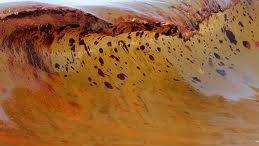Halliburton Pleads Guilty to Destroying Evidence After Gulf Spill
Source: nytimes.com
Halliburton has agreed to plead guilty to destruction of critical evidence after the Gulf of Mexico oil spill in 2010, the Justice Department announced on Thursday.  The oil services company said it would pay the maximum allowable fine of $200,000 and will be subject to three years of probation. It will also continue its cooperation in the government’s criminal investigation. Separately, Halliburton made a voluntary contribution of $55 million to the National Fish and Wildlife Foundation.
The oil services company said it would pay the maximum allowable fine of $200,000 and will be subject to three years of probation. It will also continue its cooperation in the government’s criminal investigation. Separately, Halliburton made a voluntary contribution of $55 million to the National Fish and Wildlife Foundation.The Justice Department filed one criminal charge against the company. In a statement, Halliburton said that the violation was a misdemeanor associated with the deletion of records created after the accident. Additionally, the company said, “The Department of Justice has agreed that it will not pursue further criminal prosecution of the company.”
Halliburton has suffered enormous damage to its reputation — as have BP and Transocean, the operator of the Deepwater Horizon rig — in the explosion that killed 11 workers and soiled hundreds of miles of beaches. All three companies have pleaded guilty to a criminal charge related to the spill.
[...]
Timothy Quirk, a Halliburton laboratory manager, testified that he conducted stability tests on cement samples from a similar blend that had been used in the well after the accident. Following instructions from a colleague, he said he did not prepare a laboratory work sheet. “It was unusual,” he said. He also acknowledged that he had thrown out his notes.
Later tests showed that the cement was not stable.
The failure of the cement foam seal set off a complex and ultimately deadly cascade of oil and gas up the well casing that exploded into flames to engulf the Deepwater Horizon rig. The blowout preventer, which is supposed to contain a well bore breach, also failed.
The presidential commission that investigated the accident reported that Halliburton officials knew before the explosion that the cement mixture they planned to use to seal the bottom of the well was unstable but still went ahead with the cementing.
Read the full article at: nytimes.com






















